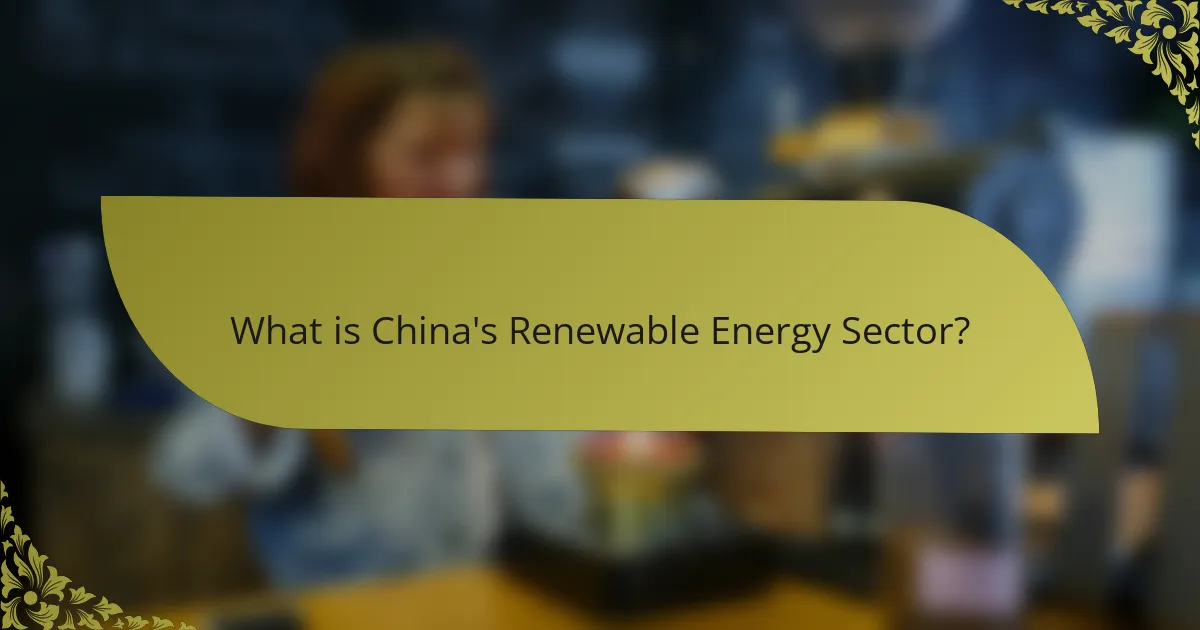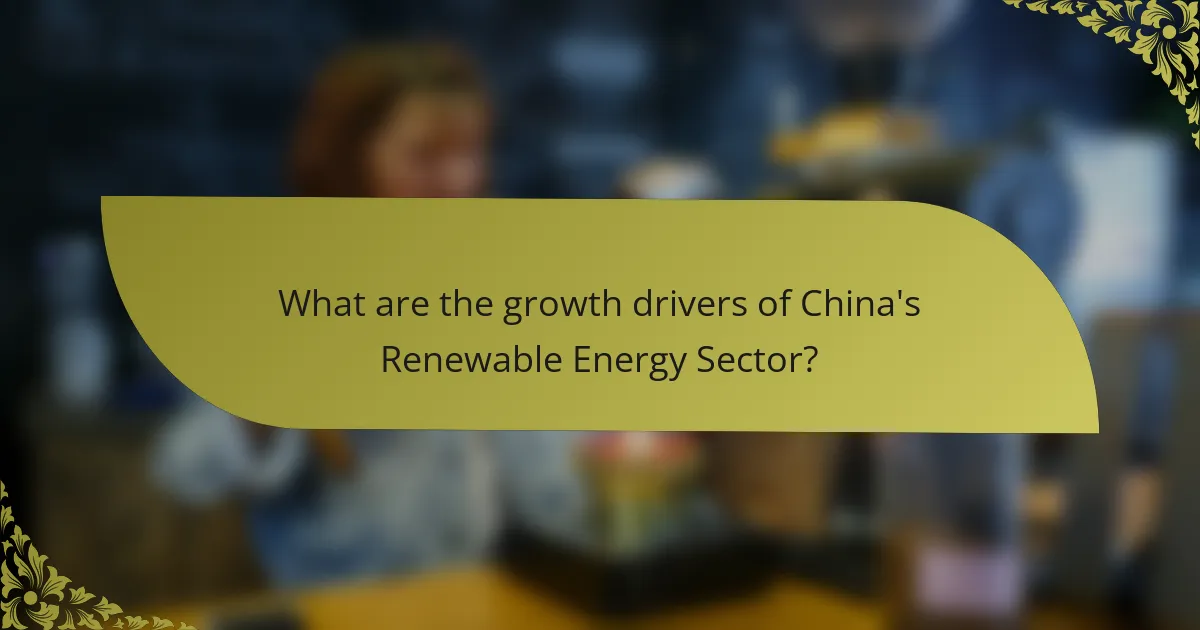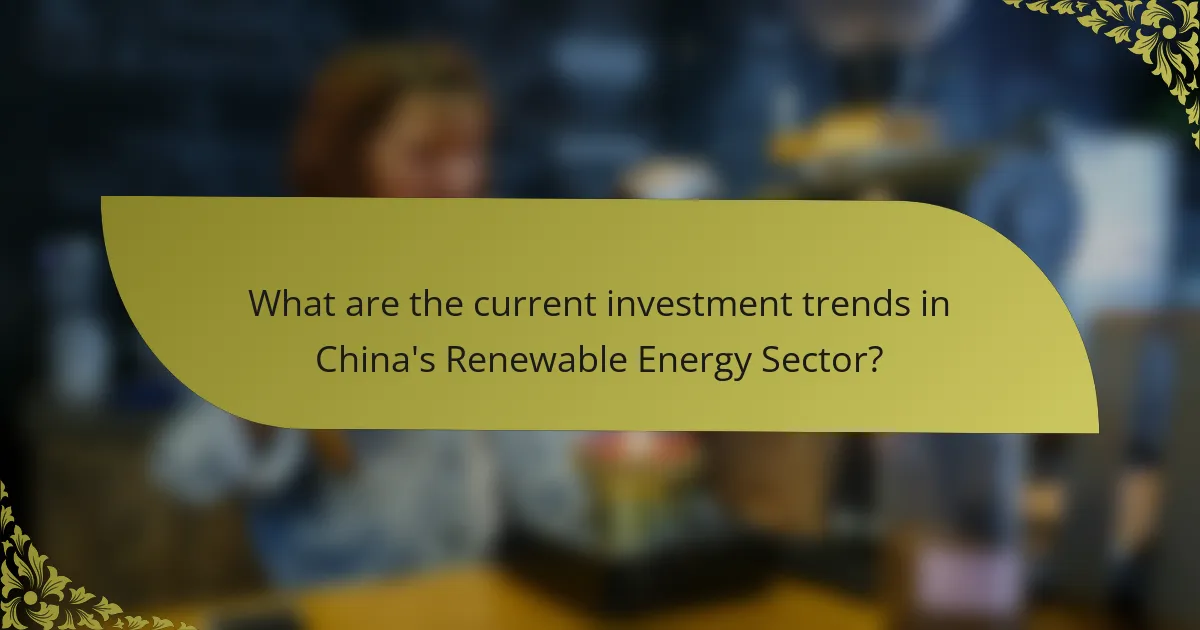China’s Renewable Energy Sector is a rapidly expanding industry focused on sustainable energy sources, including solar, wind, hydro, and biomass. As the world’s largest producer of solar panels and wind turbines, China accounted for over 29% of its total energy consumption from renewable sources in 2020. The government has set ambitious goals to enhance renewable energy capacity, aiming for 1,200 gigawatts from solar and wind by 2030. Key growth drivers include supportive government policies, technological advancements, and rising energy demand. Investment trends show a notable increase, with approximately $100 billion directed towards renewable projects in 2022, emphasizing solar and wind technologies. The sector is crucial for reducing carbon emissions and aligns with China’s commitment to achieving carbon neutrality by 2060.

What is China’s Renewable Energy Sector?
China’s Renewable Energy Sector is a rapidly growing industry focused on sustainable energy sources. It encompasses solar, wind, hydro, and biomass energy production. China is the world’s largest producer of solar panels and wind turbines. In 2020, renewable energy accounted for over 29% of China’s total energy consumption. The government has set ambitious targets to increase renewable energy capacity. By 2030, China aims to generate 1,200 gigawatts from solar and wind sources. Investments in renewable energy reached approximately $83 billion in 2020. This sector plays a crucial role in reducing carbon emissions and combating climate change.
How has China’s renewable energy sector evolved over the years?
China’s renewable energy sector has significantly evolved over the years. Initially, in the early 2000s, China focused on developing wind and solar energy technologies. By 2010, China became the world’s largest producer of solar panels. The government implemented policies to promote renewable energy, such as the Renewable Energy Law in 2005. In 2015, China led global investments in renewable energy, exceeding $100 billion. By 2020, China accounted for over 30% of global renewable energy capacity. The country has also made substantial advancements in energy storage technologies. As of 2023, China continues to innovate, aiming for carbon neutrality by 2060.
What historical events have shaped the current landscape of China’s renewable energy?
China’s renewable energy landscape has been shaped by several key historical events. The 1978 economic reforms marked the beginning of modernization and opened the door for renewable energy investments. In 2005, the Renewable Energy Law was enacted, promoting the development of wind, solar, and biomass energy. The 2008 global financial crisis led to increased government spending on renewable energy as part of economic stimulus measures. In 2010, China became the world’s largest producer of solar panels, solidifying its leadership in the sector. The 13th Five-Year Plan, introduced in 2016, set ambitious targets for renewable energy capacity, further driving growth. Additionally, international agreements like the Paris Agreement in 2015 have influenced China’s commitment to reducing carbon emissions and expanding renewable energy sources. These events collectively fostered a robust renewable energy sector in China, making it a global leader in clean energy production.
What policies have influenced the growth of renewable energy in China?
China’s growth in renewable energy has been significantly influenced by government policies. The Renewable Energy Law, enacted in 2006, established a framework for promoting renewable energy sources. This law mandated grid access for renewable energy producers. It also set feed-in tariffs to incentivize investment in solar and wind energy.
In addition, the 13th Five-Year Plan for Ecological and Environmental Protection emphasized renewable energy development. It aimed for non-fossil fuel energy to account for 15% of primary energy consumption by 2020. The government also introduced subsidies and tax incentives for renewable energy projects.
China’s commitment to international agreements, such as the Paris Agreement, further solidified its renewable energy policies. The country pledged to peak carbon emissions before 2030 and achieve carbon neutrality by 2060. These commitments have driven investments in clean energy technologies.
Overall, these policies have created a conducive environment for the growth of renewable energy in China. They have attracted both domestic and foreign investments, leading to rapid advancements in the sector.
What are the main types of renewable energy sources utilized in China?
The main types of renewable energy sources utilized in China are solar, wind, hydroelectric, and biomass energy. Solar energy has seen significant growth, with China being the world’s largest producer of photovoltaic cells. Wind energy is also a major contributor, with extensive wind farms across the country. Hydroelectric power accounts for a large portion of China’s energy supply, primarily from large dams like the Three Gorges Dam. Biomass energy is utilized for both electricity generation and heating. These sources collectively support China’s goal of increasing renewable energy’s share in its energy mix, contributing to environmental sustainability and energy security.
How do solar energy and wind energy contribute to China’s energy mix?
Solar energy and wind energy significantly contribute to China’s energy mix. As of 2022, solar energy accounted for approximately 12% of China’s total electricity generation. Wind energy contributed around 10% during the same period. China’s government has heavily invested in renewable energy projects. This investment aims to reduce reliance on fossil fuels and lower carbon emissions. The country is the world’s largest producer of solar panels. It also ranks first in wind turbine installations. These developments support China’s goal of reaching carbon neutrality by 2060. The integration of solar and wind energy enhances energy security and sustainability.
What role does hydropower play in China’s renewable energy sector?
Hydropower is a crucial component of China’s renewable energy sector. It accounts for approximately 17% of the country’s total electricity generation. China is the world’s largest producer of hydropower, with an installed capacity exceeding 350 gigawatts. Major projects, like the Three Gorges Dam, exemplify China’s commitment to hydropower development. The country aims to increase its renewable energy share, with hydropower playing a key role in achieving this goal. Hydropower helps reduce greenhouse gas emissions and reliance on fossil fuels. Furthermore, it supports energy security and provides a stable power supply to meet growing demand.
Who are the key players in China’s renewable energy sector?
The key players in China’s renewable energy sector include companies such as China National Petroleum Corporation (CNPC), China National Offshore Oil Corporation (CNOOC), and State Grid Corporation of China. These entities dominate the market through their extensive investments and infrastructure. Additionally, companies like Longi Green Energy, JinkoSolar, and Trina Solar lead in solar energy production. Goldwind and Envision Energy are significant players in wind energy. The Chinese government also plays a crucial role by implementing policies that support renewable energy initiatives. These companies and government actions collectively drive China’s position as a global leader in renewable energy.
Which companies are leading the solar energy market in China?
The leading companies in the solar energy market in China are Longi Green Energy, JinkoSolar, and Trina Solar. Longi Green Energy is known for its high-efficiency monocrystalline solar panels. JinkoSolar is recognized as one of the largest solar panel manufacturers globally. Trina Solar has a significant presence in both manufacturing and project development. These companies dominate the market due to their advanced technology and large production capacities. In 2022, Longi Green Energy had a market share of approximately 20%. JinkoSolar followed closely with around 15% market share. Trina Solar also held a substantial share, contributing to China’s position as the world’s largest solar energy market.
What are the major players in the wind energy sector?
The major players in the wind energy sector include companies like Vestas, Siemens Gamesa, GE Renewable Energy, and Goldwind. Vestas is a Danish manufacturer known for its wind turbine technology. Siemens Gamesa, a merger of Siemens Wind Power and Gamesa, is a leader in the global market. GE Renewable Energy focuses on innovative wind turbine solutions. Goldwind is a prominent Chinese company specializing in wind power generation. These companies contribute significantly to the growth of renewable energy worldwide. Their advancements in technology and capacity help meet global energy demands sustainably.

What are the growth drivers of China’s Renewable Energy Sector?
The growth drivers of China’s Renewable Energy Sector include government policies, technological advancements, and increasing energy demand. Government policies provide substantial subsidies and incentives for renewable energy projects. These initiatives aim to reduce reliance on fossil fuels and promote sustainable development. Technological advancements enhance the efficiency and cost-effectiveness of renewable energy solutions. Innovations in solar and wind technologies have significantly lowered production costs. Increasing energy demand in urban areas fuels the need for sustainable energy sources. The transition to cleaner energy aligns with China’s commitments to reduce carbon emissions. According to the International Energy Agency, China’s renewable energy capacity grew by 18% in 2021, highlighting the sector’s rapid expansion.
How does government policy support the growth of renewable energy?
Government policy supports the growth of renewable energy through financial incentives and regulatory frameworks. These policies include subsidies for renewable energy projects, tax credits, and feed-in tariffs. Such measures reduce the financial burden on developers and encourage investment. China has implemented various policies, such as the Renewable Energy Law, which mandates the purchase of renewable energy by grid companies. This law ensures a stable market for renewable energy producers. Additionally, the government sets ambitious renewable energy targets, driving innovation and expansion in the sector. In 2020, China aimed for 20% of its energy consumption to come from non-fossil sources by 2025. These initiatives collectively foster a favorable environment for renewable energy growth.
What specific incentives does the Chinese government provide for renewable energy investments?
The Chinese government provides several specific incentives for renewable energy investments. These include financial subsidies for solar and wind energy projects. The government offers feed-in tariffs, ensuring fixed payments for renewable energy producers. Tax exemptions are available for certain renewable energy equipment imports. Additionally, there are low-interest loans for renewable energy projects. The government also provides grants for research and development in clean energy technologies. Furthermore, local governments often offer additional incentives to attract renewable energy investments. These incentives aim to accelerate the growth of the renewable energy sector in China.
How do international agreements impact China’s renewable energy strategy?
International agreements significantly influence China’s renewable energy strategy. These agreements often set binding targets for emissions reductions. For instance, the Paris Agreement commits China to peak carbon emissions by 2030. This commitment drives investment in renewable technologies. China has become a leader in solar and wind energy production as a result. Furthermore, international cooperation enhances technology transfer. Agreements facilitate access to advanced renewable technologies from other countries. This access accelerates China’s renewable energy adoption. Overall, international agreements shape policy frameworks and funding priorities in China’s renewable energy sector.
What technological advancements are driving growth in renewable energy?
Technological advancements driving growth in renewable energy include improved solar panel efficiency, energy storage innovations, and smart grid technologies. Enhanced solar panels now convert over 22% of sunlight into electricity, increasing energy output. Energy storage systems, such as lithium-ion batteries, have seen costs drop by 89% since 2010, enabling better energy management. Smart grid technologies optimize electricity distribution and consumption, facilitating the integration of renewable sources. Additionally, advancements in wind turbine design have led to larger turbines that capture more wind energy. These developments collectively enhance the viability and adoption of renewable energy solutions.
How does innovation in energy storage affect renewable energy adoption?
Innovation in energy storage significantly enhances renewable energy adoption. Improved storage technologies allow for better management of energy supply and demand. This leads to increased reliability of renewable sources like solar and wind. For instance, lithium-ion batteries have reduced costs by 85% since 2010. This price drop makes renewable energy more economically viable. Additionally, energy storage systems enable grid stability, accommodating fluctuations in renewable energy generation. As a result, countries can integrate higher percentages of renewables into their energy mix. According to the International Energy Agency, energy storage capacity is expected to grow by 30% annually through 2025. This growth will further accelerate the transition to sustainable energy systems.
What role do smart grids play in enhancing renewable energy efficiency?
Smart grids enhance renewable energy efficiency by optimizing energy distribution and consumption. They integrate advanced communication technologies with traditional power systems. This integration allows for real-time data analysis and monitoring. Smart grids facilitate better management of energy resources. They enable the incorporation of diverse renewable sources like solar and wind. This leads to reduced energy waste and improved reliability. According to the International Energy Agency, smart grids can increase the efficiency of renewable energy systems by up to 30%. Enhanced grid flexibility allows for better load balancing and demand response. Overall, smart grids play a crucial role in maximizing the potential of renewable energy sources.
Why is public awareness and consumer demand important for the sector’s growth?
Public awareness and consumer demand are crucial for the growth of China’s renewable energy sector. Increased awareness leads to higher acceptance of renewable technologies. This acceptance drives consumer demand for renewable energy products and services. When consumers prioritize renewable energy, it encourages investments in the sector. Investment leads to innovation and the development of new technologies. For instance, in 2020, China’s renewable energy investments reached $83 billion, reflecting strong consumer interest. Additionally, public awareness campaigns can educate consumers about the benefits of renewable energy. This education can further stimulate demand and support policy changes favoring renewables. Overall, public awareness and consumer demand create a positive feedback loop that propels sector growth.
How does the public’s perception of climate change influence renewable energy adoption?
Public perception of climate change significantly influences renewable energy adoption. When the public acknowledges climate change as a pressing issue, they tend to support renewable energy initiatives. This support can manifest in increased demand for clean energy solutions. For instance, surveys indicate that over 70% of people in many countries believe in the urgency of addressing climate change. Consequently, this belief can lead to greater political and economic backing for renewable energy projects. In China, public concern has driven government policies favoring solar and wind energy investments. Research shows that regions with higher climate change awareness see faster renewable energy deployment. Thus, public perception is a critical factor in shaping renewable energy adoption trends.
What trends are emerging in consumer behavior regarding renewable energy sources?
Consumers are increasingly favoring renewable energy sources due to environmental concerns and cost savings. A significant trend is the growing demand for solar energy solutions. In 2022, global solar installations reached 200 gigawatts, reflecting consumer preference for sustainable options. Additionally, there is a shift towards home energy storage systems. These systems allow consumers to store solar energy for later use, enhancing energy independence.
Another trend is the rise of community solar projects. These initiatives enable consumers to invest in shared solar arrays, making renewable energy accessible to those unable to install solar panels on their properties. Furthermore, consumers are becoming more informed about energy choices. According to a 2023 survey, 75% of consumers prioritize sustainability when choosing energy providers.
Lastly, government incentives are influencing consumer behavior. Subsidies and tax credits for renewable energy installations are driving adoption rates. In China, the government aims for 20% of energy consumption from non-fossil sources by 2025, encouraging consumer participation in the renewable energy market.

What are the current investment trends in China’s Renewable Energy Sector?
China’s Renewable Energy Sector is experiencing significant investment trends focused on solar, wind, and energy storage technologies. In 2022, China’s investment in renewable energy reached approximately $100 billion, marking a 20% increase from the previous year. Solar energy continues to dominate, with investments in photovoltaic technology accounting for over 50% of total renewable investments. Wind energy is also gaining traction, with offshore wind projects attracting substantial funding.
The Chinese government is actively promoting green finance initiatives, enhancing investments in renewable projects. Additionally, state-owned enterprises are leading the charge, driving innovation and efficiency in the sector. The global push for carbon neutrality by 2060 further propels investment in renewable technologies.
China’s renewable energy sector is positioned as a global leader, influencing market trends worldwide. The country’s commitment to reducing carbon emissions is expected to sustain these investment trends in the coming years.
How much investment is flowing into China’s renewable energy sector?
In 2022, investment in China’s renewable energy sector reached approximately $100 billion. This figure represents a significant increase compared to previous years. The growth is driven by government policies and global demand for clean energy. China leads the world in solar and wind energy capacity. In 2021, it added over 50 gigawatts of solar power. The country also invested heavily in electric vehicle infrastructure. These investments support China’s goal of carbon neutrality by 2060. The renewable energy sector is a vital part of China’s economic strategy.
What are the major sources of funding for renewable energy projects in China?
The major sources of funding for renewable energy projects in China include government subsidies, bank loans, and foreign investments. Government subsidies play a crucial role in providing financial support for renewable energy initiatives. These subsidies often come from national and local governments aiming to promote clean energy. Bank loans are another significant funding source, with Chinese banks actively financing renewable energy projects. Foreign investments also contribute to funding, as international investors seek opportunities in China’s growing renewable sector. According to the International Energy Agency, China accounted for over 30% of global renewable energy investment in 2020. This highlights the country’s substantial commitment to funding its renewable energy projects.
How do foreign investments impact the growth of China’s renewable energy market?
Foreign investments significantly enhance the growth of China’s renewable energy market. They provide essential capital for developing new technologies and infrastructure. For instance, in 2020, foreign direct investment (FDI) in China’s renewable energy sector reached approximately $9 billion. This influx of funds supports projects in solar, wind, and hydroelectric power. Furthermore, foreign companies bring expertise and innovative practices that boost efficiency. Collaborations with international firms often lead to knowledge transfer, improving local capabilities. As a result, China’s renewable energy capacity has expanded rapidly, making it a global leader. In 2021, China accounted for over 30% of global renewable energy investments. This trend is expected to continue, driven by favorable policies and international partnerships.
What are the emerging opportunities for investors in renewable energy?
Emerging opportunities for investors in renewable energy include advancements in solar and wind technologies. China leads the world in solar panel production, with a market share of over 70%. The country aims to reach carbon neutrality by 2060, driving investment in clean energy sources. Battery storage technologies are also gaining traction, enhancing energy reliability. The government offers subsidies and incentives for renewable energy projects, increasing their attractiveness to investors. Additionally, electric vehicle (EV) infrastructure is expanding rapidly, creating new investment avenues. According to the International Energy Agency, global renewable energy capacity is projected to grow by 50% by 2024, highlighting significant market potential.
Which regions in China are seeing the most investment in renewable energy?
The regions in China seeing the most investment in renewable energy include Guangdong, Jiangsu, and Shandong. Guangdong has become a leader due to its strong industrial base and government support. Jiangsu follows closely with substantial investments in solar and wind energy projects. Shandong is also notable for its focus on wind power and biomass energy. These regions collectively attract a significant portion of China’s renewable energy funding. According to the China Renewable Energy Industry Association, these areas accounted for over 50% of the nation’s total renewable energy investments in 2022.
What new technologies are attracting investment in the renewable energy sector?
Emerging technologies attracting investment in the renewable energy sector include solar photovoltaic advancements, wind turbine innovations, and energy storage systems. Solar photovoltaic technologies are becoming more efficient, with some panels achieving over 22% efficiency. Wind turbine advancements are also notable, with larger, more efficient turbines generating more power. Energy storage systems, particularly lithium-ion batteries, are crucial for balancing supply and demand. According to BloombergNEF, global investment in energy storage is expected to exceed $620 billion by 2040. Additionally, hydrogen production technologies are gaining traction, with investments in green hydrogen projects increasing significantly. These technologies are essential for transitioning to a more sustainable energy landscape.
What challenges do investors face in China’s renewable energy sector?
Investors in China’s renewable energy sector face several significant challenges. Regulatory uncertainty complicates investment decisions. Frequent changes in policies can affect project viability. Additionally, competition from state-owned enterprises can hinder market entry for private investors. Access to financing remains a concern, as banks may favor established players. Infrastructure limitations can delay project implementation. Furthermore, fluctuating demand for renewable energy can impact profitability. Environmental concerns and local opposition may also pose risks to project approval. These factors collectively create a complex investment landscape in China’s renewable energy market.
How do regulatory hurdles affect investment decisions?
Regulatory hurdles significantly impact investment decisions in China’s renewable energy sector. These hurdles create uncertainty and increase compliance costs for investors. Investors may delay or reduce investments due to complex regulatory requirements. For example, the National Energy Administration’s policies can influence project approvals and funding availability. Additionally, changing regulations can lead to market instability. A study by the International Renewable Energy Agency found that regulatory clarity boosts investor confidence and attracts capital. Therefore, clear and stable regulations are crucial for fostering investment in renewable energy.
What market risks should investors be aware of in this sector?
Investors in China’s renewable energy sector should be aware of several market risks. Regulatory changes can significantly impact project viability and profitability. For instance, alterations in government subsidies or tariffs may affect financial returns. Additionally, competition is intensifying, leading to price pressures on energy producers. Market volatility can arise from fluctuating demand for renewable energy sources. Technological advancements may render existing solutions obsolete, posing risks to established companies. Supply chain disruptions can affect the availability of critical components, delaying projects. Lastly, geopolitical tensions may impact international partnerships and trade, further complicating market dynamics.
What best practices should investors follow in China’s renewable energy sector?
Investors in China’s renewable energy sector should conduct thorough market research. Understanding government policies and incentives is crucial. China has set ambitious renewable energy targets, aiming for 20% of primary energy consumption by 2025. Investors should evaluate the financial health of companies before investing. The sector is rapidly evolving, with innovations in technology and efficiency. Diversification across various renewable energy sources can mitigate risks. Engaging with local partners can provide valuable insights and access to networks. Monitoring global trends in renewable energy can inform investment strategies. Adapting to regulatory changes is essential for long-term success.
China’s Renewable Energy Sector is a rapidly expanding industry focused on sustainable energy sources, including solar, wind, hydro, and biomass. The article examines the evolution of this sector, highlighting key historical events, government policies, and the main types of renewable energy utilized. It also identifies major players in the market, investment trends, and emerging opportunities for investors, while addressing challenges and best practices for navigating the complex landscape. Overall, the content provides a comprehensive overview of the growth drivers and current dynamics shaping China’s position as a global leader in renewable energy.



